Mechanical and Tribological Behaviors of Hot-Pressed SiC/SiCw-Y2O3 Ceramics with Different Y2O3 Contents
Abstract
1. Introduction
2. Experimental
2.1. Raw Powders
2.2. Hot-Pressed Sintering of SiC/SiCw-Y2O3 Ceramics
2.3. Sample Characterization
2.4. Mechanical Properties
2.4.1. Relative Density
2.4.2. Vickers Hardness
2.4.3. Fracture Toughness
2.4.4. Flexural Strength
2.5. Tribological Behavior
3. Results and Discussion
4. Conclusions
Author Contributions
Funding
Institutional Review Board Statement
Informed Consent Statement
Data Availability Statement
Conflicts of Interest
References
- Xu, M.; Girish, Y.R.; Rakesh, K.P.; Wu, P.; Manukumar, H.M.; Byrappa, S.M.; Udayabhanu; Byrappa, K. Recent advances and challenges in silicon carbide (SiC) ceramic nanoarchitectures and their applications. Mater. Today Commun. 2021, 28, 102533. [Google Scholar] [CrossRef]
- Padture, N.P. Advanced structural ceramics in aerospace propulsion. Nat. Mater. 2016, 15, 804–809. [Google Scholar] [CrossRef] [PubMed]
- Kang, S.-J.L. What we should consider for full densification when sintering. Materials 2020, 13, 3578. [Google Scholar] [CrossRef]
- Shimoda, K.; Hinoki, T. Effects of fiber volume fraction on the densification and mechanical properties of unidirectional SiCf/SiC-matrix composites. J. Eur. Ceram. Soc. 2021, 41, 1163–1170. [Google Scholar] [CrossRef]
- Wei, C.; Zhang, Z.; Ma, X.; Liu, L.; Wu, Y.; Li, D.; Wang, P.; Duan, X. Mechanical and ablation properties of laminated ZrB2-SiC ceramics with Si3N4 whisker interface. Corros. Sci. 2022, 10, 17003–17009. [Google Scholar] [CrossRef]
- Li, S.; Zhang, Y.; Han, J.; Zhou, Y. Fabrication and characterization of SiC whisker reinforced reaction bonded SiC composite. Ceram. Int. 2013, 39, 449–455. [Google Scholar] [CrossRef]
- Song, N.; Zhang, H.-B.; Liu, H.; Fang, J.-Z. Effects of SiC whiskers on the mechanical properties and microstructure of SiC ceramics by reactive sintering. Ceram. Int. 2017, 43, 6786–6790. [Google Scholar] [CrossRef]
- Yang, Y.; Zhu, T.; Sun, N.; Liang, X.; Li, Y.; Wang, H.; Xie, Z.; Sang, S.; Dai, J. Mechanical and tribological properties of SiC whiskers reinforced SiC composites via oscillatory pressure sintering. Int. J. Appl. Ceram. Technol. 2023, 12, 1–12. [Google Scholar] [CrossRef]
- Zhang, L.; Yang, H.; Guo, X.; Shen, J.; Zhu, X. Preparation and properties of silicon carbide ceramics enhanced by TiN nanoparticles and SiC whiskers. Scr. Mater. 2011, 65, 186–189. [Google Scholar] [CrossRef]
- Kim, K.-J.; Lim, K.-Y.; Kim, Y.-W. Influence of Y2O3 addition on electrical properties of β-SiC ceramics sintered in nitrogen atmosphere. J. Eur. Ceram. Soc. 2012, 32, 4401–4406. [Google Scholar] [CrossRef]
- Xie, W.; Fu, Q.; Cheng, C. Oxidation behavior of different La2O3-content modified SiC ceramic at 1700 degrees C. Ceram. Int. 2021, 47, 11560–11567. [Google Scholar] [CrossRef]
- Tabata, S.; Hirata, Y.; Sameshima, S.; Matsunaga, N.; Ijichi, K. Liquid phase sintering and mechanical properties of SiC with rare-earth oxide. J. Ceram. Soc. Jpn. 2006, 114, 247–252. [Google Scholar] [CrossRef]
- Liang, H.; Yao, X.; Zhang, J.; Liu, X.; Huang, Z. The effect of rare earth oxides on the pressureless liquid phase sintering of alpha-SiC. J. Eur. Ceram. Soc. 2014, 34, 2865–2874. [Google Scholar] [CrossRef]
- Raju, K.; Yoon, D.-H. Sintering additives for SiC based on the reactivity: A review. Ceram. Int. 2016, 42, 17947–17962. [Google Scholar] [CrossRef]
- Maity, T.; Kim, Y.-W. High-temperature strength of liquid-phase-sintered silicon carbide ceramics: A review. Int. J. Appl. Ceram. Technol. 2022, 19, 130–148. [Google Scholar] [CrossRef]
- Strecker, K.; Ribeiro, S.; Oberacker, R.; Hoffmann, M.J. Influence of microstructural variation on fracture toughness of LPS-SiC ceramics. Int. J. Refract. Met. Hard Mater. 2004, 22, 169–175. [Google Scholar] [CrossRef]
- Santos, A.; Ribeiro, S. Liquid phase sintering and characterization of SiC ceramics. Ceram. Int. 2018, 44, 11048–11059. [Google Scholar] [CrossRef]
- Ge, S.; Yao, X.; Liu, Y.; Duan, H.; Huang, Z.; Liu, X. Effect of Sintering Temperature on the Properties of Highly Electrical Resistive SiC Ceramics as a Function of Y2O3-Er2O3 Additions. Materials 2020, 13, 4768. [Google Scholar] [CrossRef]
- Seo, Y.-K.; Kim, Y.-W.; Kim, K.-J. Electrically conductive SiC-BN composites. J. Eur. Ceram. Soc. 2016, 36, 3879–3887. [Google Scholar] [CrossRef]
- Zhu, Y.; Qin, Z.; Chai, J.; Shen, T.; Zhou, Y.; Wang, Z. Effects of sintering additives on microstructure and mechanical properties of hot-pressed alpha-SiC. Metall. Mater. Trans. A 2022, 53, 1188–1199. [Google Scholar] [CrossRef]
- Lim, K.-Y.; Kim, Y.-W.; Kim, K.J. Mechanical properties of electrically conductive silicon carbide ceramics. Ceram. Int. 2014, 40, 10577–10582. [Google Scholar] [CrossRef]
- Kueck, A.; Ramasse, Q.; De Jonghe, L.; Ritchie, R. Atomic-scale imaging and the effect of yttrium on the fracture toughness of silicon carbide ceramics. Acta Mater. 2010, 58, 2999–3005. [Google Scholar] [CrossRef]
- Gao, J.; Xiao, H.; Du, H. Effect of Y2O3 addition on ammono sol–gel synthesis and sintering of Si3N4–SiC nanocomposite powder. Ceram. Int. 2003, 29, 655–661. [Google Scholar] [CrossRef]
- Zhang, Y.; Yu, X.; Gu, H.; Yao, D.; Zuo, K.; Xia, Y.; Yin, J.; Liang, H.; Zeng, Y.-P. Microstructure evolution and high-temperature mechanical properties of porous Si3N4 ceramics prepared by SHS with a small amount of Y2O3 addition. Ceram. Int. 2021, 47, 5656–5662. [Google Scholar] [CrossRef]
- Cheng, L.; Xie, Z.; Liu, J.; Wu, H.; Jiang, Q.; Wu, S. Effects of Y2O3 on the densification and fracture toughness of SPS-sintered TiC. Mater. Res. Innov. 2018, 22, 7–12. [Google Scholar] [CrossRef]
- Zhang, X.; Li, X.; Han, J.; Han, W.; Hong, C. Effects of Y2O3 on microstructure and mechanical properties of ZrB2–SiC ceramics. J. Alloys Compd. 2008, 465, 506–511. [Google Scholar] [CrossRef]
- Kováčová, Z.; Bača, Ľ.; Neubauer, E.; Kitzmantel, M. Influence of sintering temperature, SiC particle size and Y2O3 addition on the densification, microstructure and oxidation resistance of ZrB2-SiC ceramics. J. Eur. Ceram. Soc. 2016, 36, 3041–3049. [Google Scholar] [CrossRef]
- Aguirre, T.G.; Lamm, B.W.; Cramer, C.L.; Mitchell, D.J. Zirconium-diboride silicon-carbide composites: A review. Ceram. Int. 2022, 48, 7344–7361. [Google Scholar] [CrossRef]
- Aguirre, T.G.; Cramer, C.L.; Cakmak, E.; Lance, M.J.; Lowden, R.A. Processing and microstructure of ZrB2–SiC composite prepared by reactive spark plasma sintering. Results Mater. 2021, 11, 100217. [Google Scholar] [CrossRef]
- Li, W.; Zhang, X.; Hong, C.; Han, J.; Han, W. Hot-pressed ZrB2-SiC-YSZ composites with various yttria content: Microstructure and mechanical properties. Mater. Sci. Eng. A 2008, 494, 147–152. [Google Scholar] [CrossRef]
- Serbenyuk, T.B.; Prikhna, T.O.; Sverdun, V.B.; Sverdun, N.V.; Moshchil’, V.Y.; Ostash, O.P.; Vasyliv, B.D.; Podhurska, V.Y.; Kovylyaev, V.V.; Chasnyk, V.I. Effect of the additive of Y2O3 on the structure formation and properties of composite materials based on AlN-SiC. J. Superhard Mater. 2018, 40, 8–15. [Google Scholar] [CrossRef]
- Wang, J.; Zuo, D.; Zhu, L.; Li, W.; Tu, Z.; Dai, S. Effects and influence of Y2O3 addition on the microstructure and mechanical properties of binderless tungsten carbide fabricated by spark plasma sintering. Int. J. Refract. Met. Hard Mater. 2018, 71, 167–174. [Google Scholar] [CrossRef]
- Wang, J.; Zuo, D.; Zhu, L.; Tu, Z.; Lin, X.; Wu, Y.; Li, W.; Zhang, X. Effect of Y2O3 addition on high-temperature oxidation of binderless tungsten carbide. Front. Mater. 2021, 8, 645612. [Google Scholar] [CrossRef]
- Liu, Y.; Li, X.; Zhou, J.; Fu, K.; Wei, W.; Du, M.; Zhao, X. Effects of Y2O3 addition on microstructures and mechanical properties of WC–Co functionally graded cemented carbides. Int. J. Refract. Met. Hard Mater. 2015, 50, 53–58. [Google Scholar] [CrossRef]
- Hu, C.; Xiang, W.; Chen, P.; Li, Q.; Xiang, R.; Zhou, L. Influence of Y2O3 on densification, flexural strength and heat shock resistance of cordierite-based composite ceramics. Ceram. Int. 2022, 48, 74–81. [Google Scholar] [CrossRef]
- Barick, P.; Chakravarty, D.; Saha, B.P.; Mitra, R.; Joshi, S.V. Effect of pressure and temperature on densification, microstructure and mechanical properties of spark plasma sintered silicon carbide processed with beta-silicon carbide nanopowder and sintering additives. Ceram. Int. 2016, 42, 3836–3848. [Google Scholar] [CrossRef]
- Gupta, S.; Sharma, S.K.; Kumar, B.V.M.; Kim, Y.-W. Tribological characteristics of SiC ceramics sintered with a small amount of yttria. Ceram. Int. 2015, 41, 14780–14789. [Google Scholar] [CrossRef]
- Guo, X.; Yang, H.; Zhang, L.; Zhu, X. Sintering behavior, microstructure and mechanical properties of silicon carbide ceramics containing different nano-TiN additive. Ceram. Int. 2010, 36, 161–165. [Google Scholar] [CrossRef]
- Niihara, K.; Morena, R.; Hasselman, D.P.H. Evaluation of KIC of brittle solids by the indentation method with low crack-to-indent ratios. J. Mater. Sci. Lett. 1982, 1, 533–538. [Google Scholar] [CrossRef]
- Sharma, S.K.; Kumar, B.V.M.; Kim, Y.-W. Tribological behavior of silicon carbide ceramics—A Review. J. Korean Ceram. Soc. 2016, 53, 581–596. [Google Scholar] [CrossRef]
- Kumar, B.V.M.; Kim, Y.-W.; Lim, D.-S.; Seo, W.-S. Influence of small amount of sintering additives on unlubricated sliding wear properties of SiC ceramics. Ceram. Int. 2011, 37, 3599–3608. [Google Scholar] [CrossRef]
- Zhang, W.; Yamashita, S.; Kita, H. Progress in tribological research of SiC ceramics in unlubricated sliding-A review. Mater. Des. 2020, 190, 108528. [Google Scholar] [CrossRef]
- Fischer, T.; Zhu, Z.; Kim, H.; Shin, D. Genesis and role of wear debris in sliding wear of ceramics. Wear 2000, 245, 53–60. [Google Scholar] [CrossRef]
- Xia, H.; Qiao, G.; Zhou, S.; Wang, J. Reciprocating friction and wear behavior of reaction-formed SiC ceramic against bearing steel ball. Wear 2013, 303, 276–285. [Google Scholar] [CrossRef]
- Cho, S.-J.; Um, C.-D.; Kim, S.-S. Wear and Wear Transition in Silicon Carbide Ceramics during Sliding. J. Am. Ceram. Soc. 1996, 79, 1247–1251. [Google Scholar] [CrossRef]
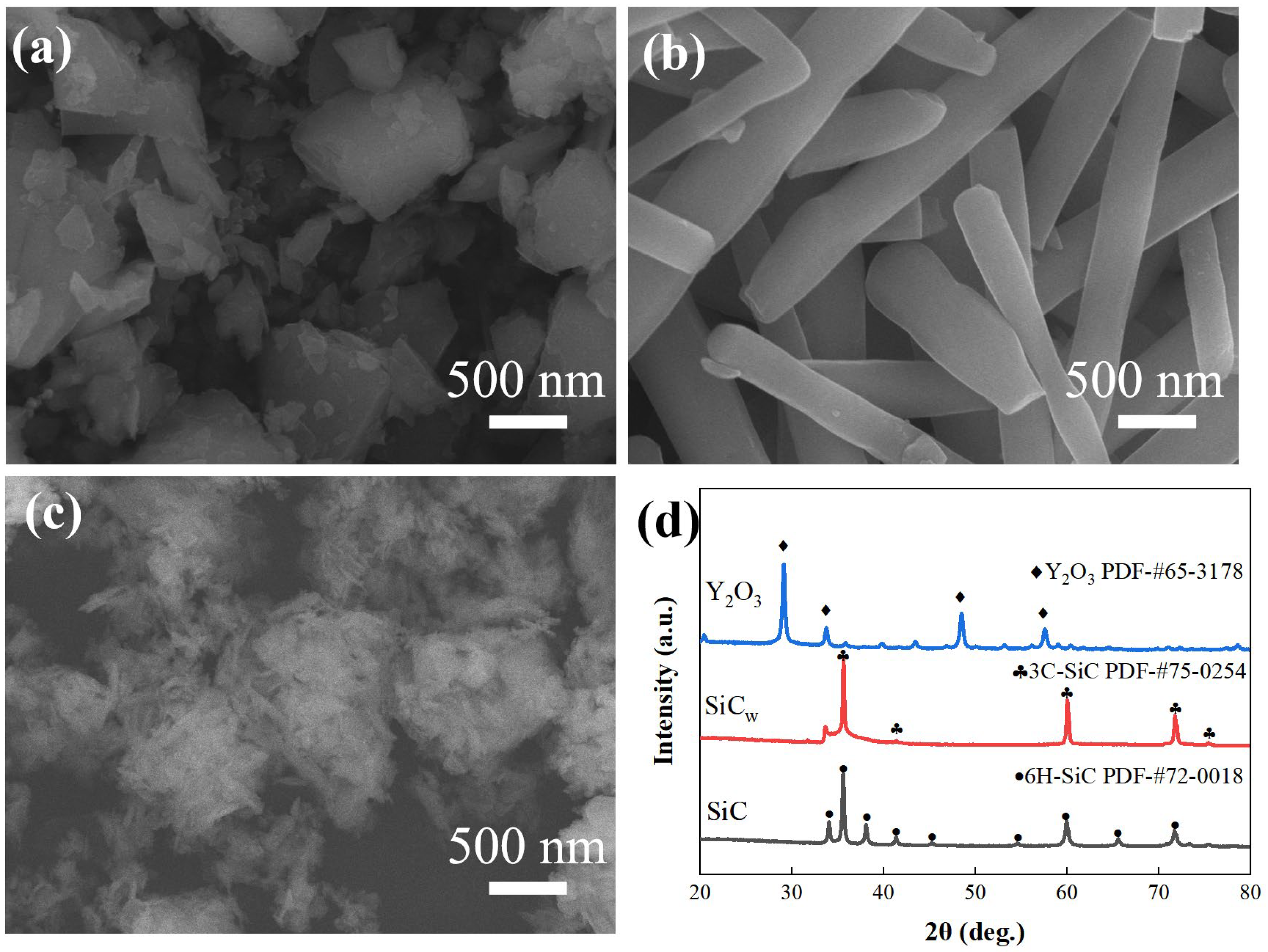

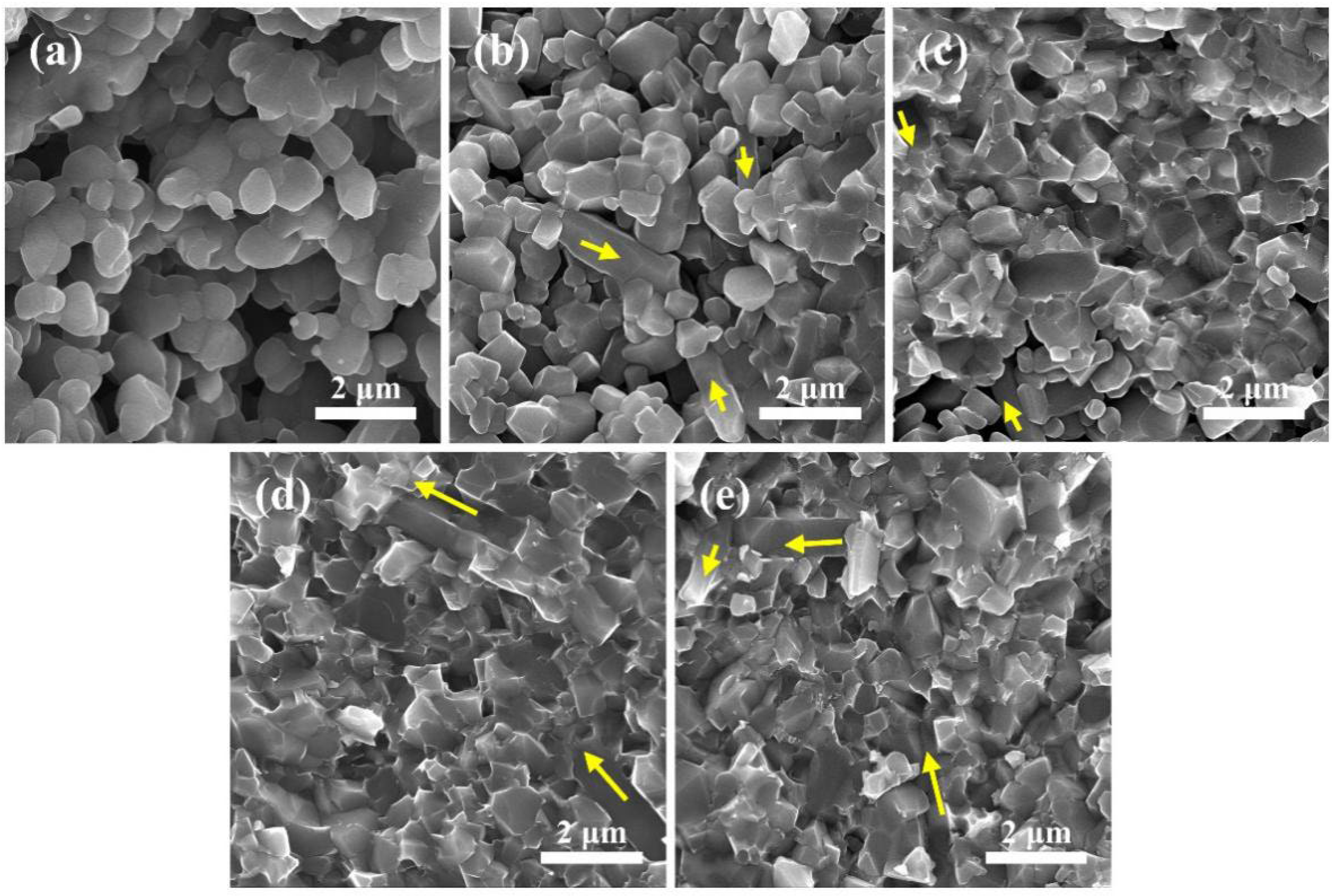
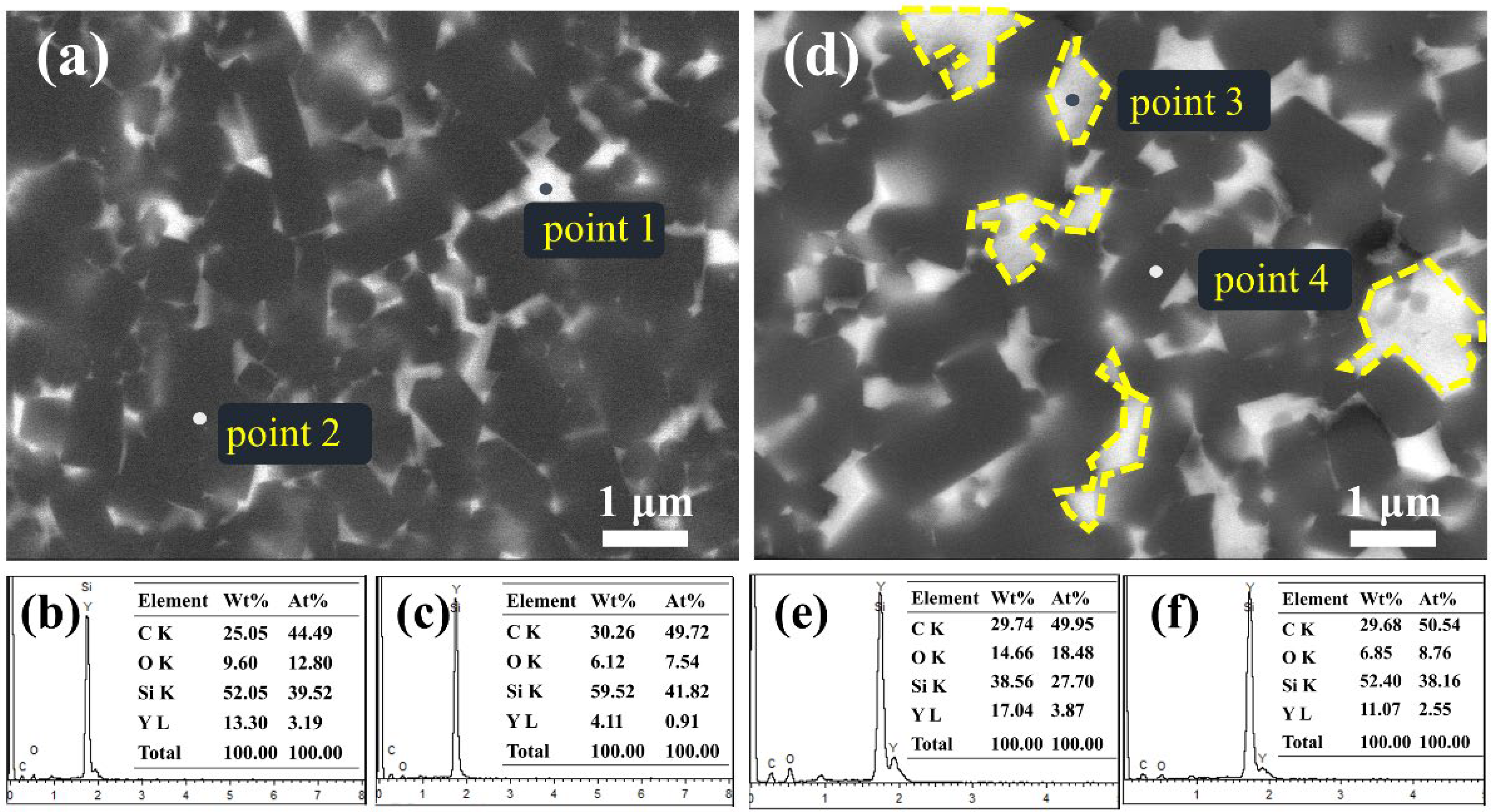

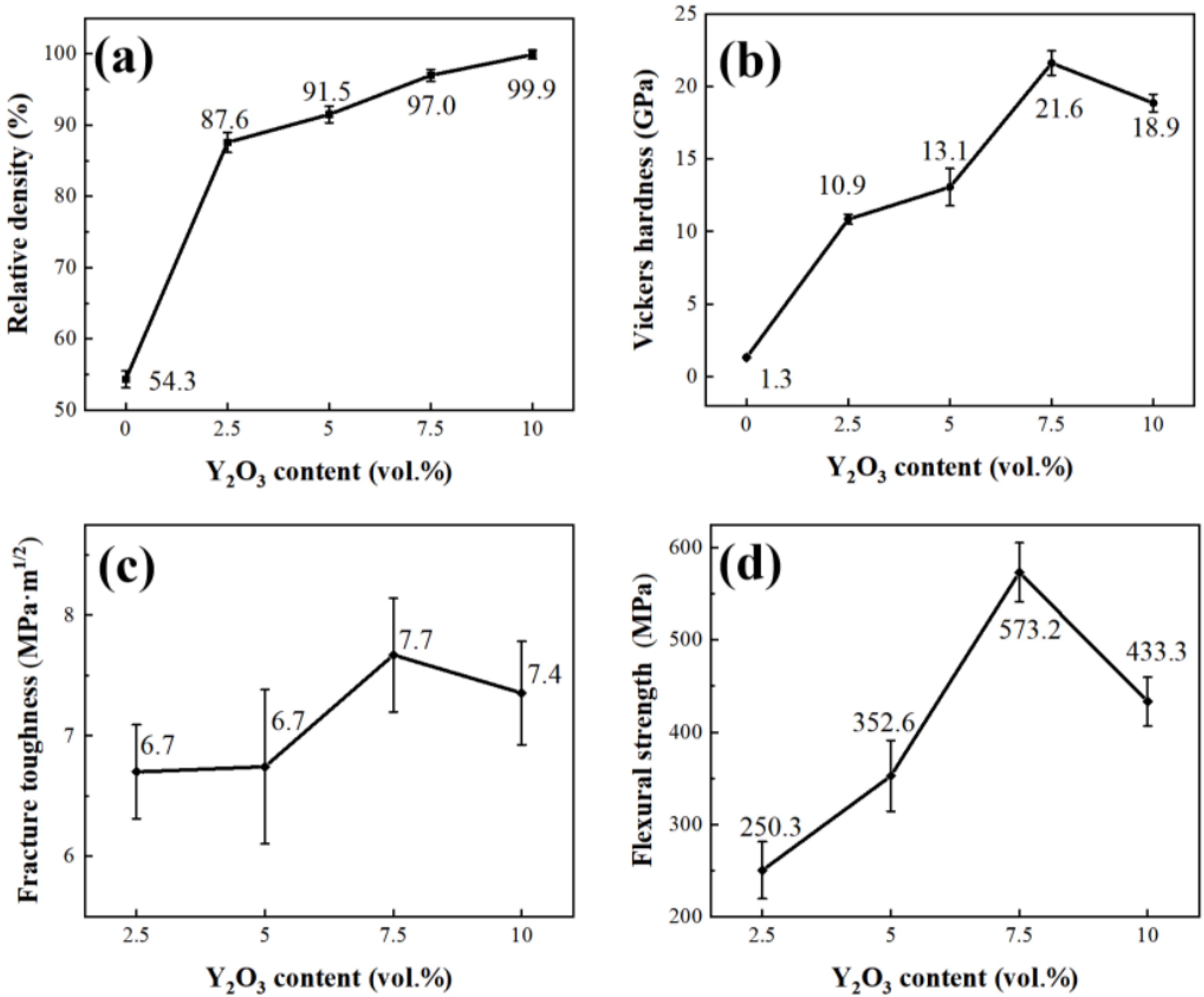
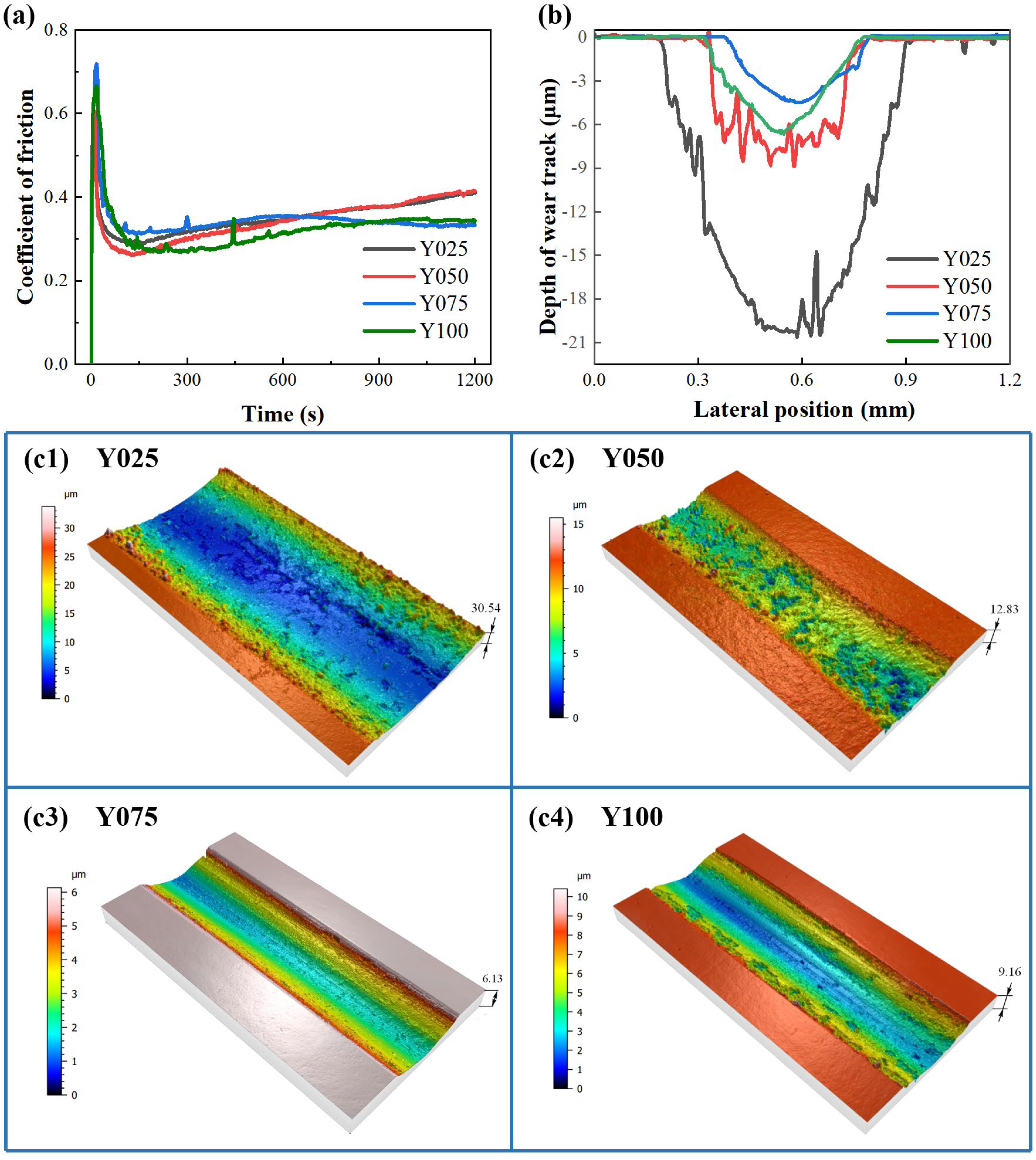

| Maximum Depth (mm) | Maximum Width (mm) | Wear Volume (mm3) | Specific Wear Rate (mm3/(N · m)) | |
|---|---|---|---|---|
| Y025 | 2.63 × 10−2 | 7.30 × 10−1 | 3.25 × 10−2 | 1.35 × 10−4 |
| Y050 | 1.25 × 10−2 | 5.01 × 10−1 | 7.74 × 10−3 | 3.23 × 10−5 |
| Y075 | 7.44 × 10−3 | 4.09 × 10−1 | 3.82 × 10−3 | 1.59 × 10−5 |
| Y100 | 8.23 × 10−3 | 4.51 × 10−1 | 6.46 × 10−3 | 2.69 × 10−5 |
Disclaimer/Publisher’s Note: The statements, opinions and data contained in all publications are solely those of the individual author(s) and contributor(s) and not of MDPI and/or the editor(s). MDPI and/or the editor(s) disclaim responsibility for any injury to people or property resulting from any ideas, methods, instructions or products referred to in the content. |
© 2023 by the authors. Licensee MDPI, Basel, Switzerland. This article is an open access article distributed under the terms and conditions of the Creative Commons Attribution (CC BY) license (https://creativecommons.org/licenses/by/4.0/).
Share and Cite
Zhang, S.; Wang, J.; Zhang, M.; Ding, L.; Chan, H.; Liu, X.; Wu, F.; Tu, Z.; Shao, L.; Ye, N.; et al. Mechanical and Tribological Behaviors of Hot-Pressed SiC/SiCw-Y2O3 Ceramics with Different Y2O3 Contents. Coatings 2023, 13, 956. https://doi.org/10.3390/coatings13050956
Zhang S, Wang J, Zhang M, Ding L, Chan H, Liu X, Wu F, Tu Z, Shao L, Ye N, et al. Mechanical and Tribological Behaviors of Hot-Pressed SiC/SiCw-Y2O3 Ceramics with Different Y2O3 Contents. Coatings. 2023; 13(5):956. https://doi.org/10.3390/coatings13050956
Chicago/Turabian StyleZhang, Shaohua, Jinfang Wang, Meng Zhang, Longqi Ding, Huijun Chan, Xiyu Liu, Fengqing Wu, Zhibiao Tu, Ling Shao, Nengyong Ye, and et al. 2023. "Mechanical and Tribological Behaviors of Hot-Pressed SiC/SiCw-Y2O3 Ceramics with Different Y2O3 Contents" Coatings 13, no. 5: 956. https://doi.org/10.3390/coatings13050956
APA StyleZhang, S., Wang, J., Zhang, M., Ding, L., Chan, H., Liu, X., Wu, F., Tu, Z., Shao, L., Ye, N., Dai, S., Zhu, L., & Chen, S. (2023). Mechanical and Tribological Behaviors of Hot-Pressed SiC/SiCw-Y2O3 Ceramics with Different Y2O3 Contents. Coatings, 13(5), 956. https://doi.org/10.3390/coatings13050956






